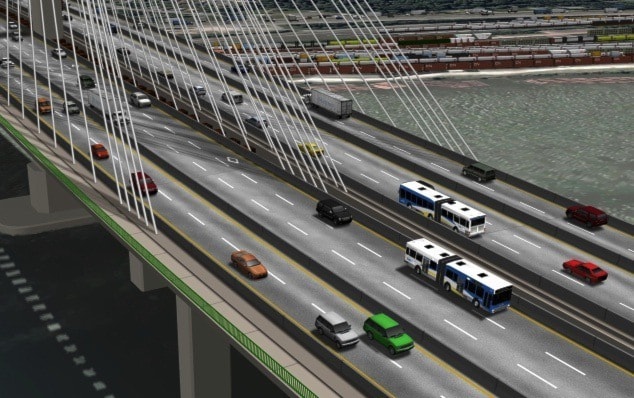Most regular users of Metro Vancouver toll bridges will likely pay using decals – which will be provided free – instead of leased transponders once the new Port Mann Bridge joins the Golden Ears Bridge as paid Fraser River crossings late this year.
It had been assumed transponders, small devices mounted on the dash for electronic detection by bridge sensors, would be set up to work with both bridges.
But the provincial transportation ministry has instead chosen windshield stickers for use on the Port Mann and TransLink has decided to also adopt them for the Golden Ears.
The bandaid-sized decals will work much the same as the transponders that are leased by Golden Ears users. Both use a radio-frequency ID tag to send an identifying signal to the bridge and the linked account of the vehicle is automatically debited each time it crosses.
"You'll put the sticker inside your window," TransLink spokesman Ken Hardie said, adding they'll be available as early as this summer.
"It will make it very, very easy for people to use whatever bridge works best for them."
Many Golden Ears Bridge users pay $1 a month to lease transponders in order to get a lower toll rate than non-users, who are instead identified by licence plate detection cameras as they cross the bridge and are billed by mail if they don't register. (Transponder users pay $2.90, versus $3.45 for registered video users and $4.10 for unregistered users.)
Decal users will also get that lowest rate, Hardie said.
Work has been underway on "interoperability" plans between the two bridges to ensure motorists don't need two different devices in their vehicles.
Hardie said TransLink won't force Golden Ears QuickPass transponder users to switch over to the decals.
He said both bridges will be set up to detect both devices, but it's not clear why users would pay to lease a transponder if decals are free.
"The ability will be there to keep the transponder if that's what works best for you," Hardie said. "We would expect for a variety of reasons people would make the transition to the decal."
TransLink plans to keep the current pricing structure for the Golden Ears Bridge, rather than adopting the one to be used on the Port Mann.
Instead of offering a discount to vehicles that are electronically detected, the Port Mann Bridge will instead charge a late fee if users who don't link a credit card or bank account fail to pay promptly.
Plans initially called for the late charge to be $2.30 after two days – on top of the $3 base toll – but the province said the amount and grace period have not yet been finalized.
Motorists will initially get two separate account statements or invoices for the two bridges, but TransLink and the province aim to eventually have a single invoice system.
The Golden Ears Bridge was free to motorists for the first couple of months after it opened in 2009 to encourage drivers to try it.
But transportation ministry spokesperson Kate Trotter said there are no plans for a toll-free period when the new Port Mann opens in December of 2012.
Eight of the 10 lanes will be open initially until the approaches for the final two lanes are disconnected from the old bridge and reconnected to the new one.
"This doubles the westbound capacity of the crossing and bridge users will see immediate travel time savings," Trotter said.
The Golden Ears Bridge still isn't attracting as many motorists as TransLink first forecast.
But Hardie said the numbers are improving, with total crossings for 2011 expected to be nearly 9.7 million, up from 8.7 million in 2010.
It's expected the number of Golden Ears users will increase in 2013 when the Port Mann downstream is no longer free.
